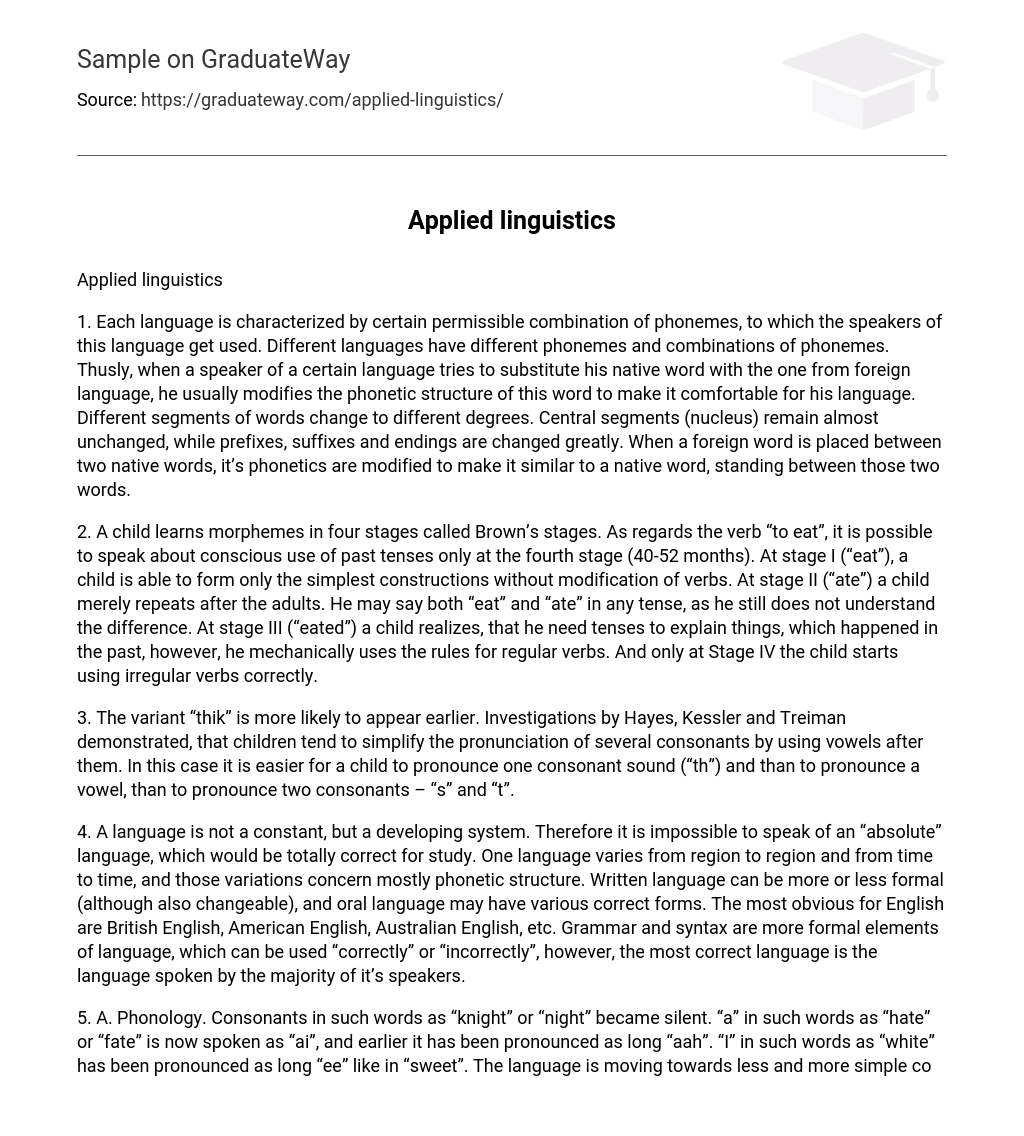1. Each language is characterized by certain permissible combination of phonemes, to which the speakers of this language get used. Different languages have different phonemes and combinations of phonemes. Thusly, when a speaker of a certain language tries to substitute his native word with the one from foreign language, he usually modifies the phonetic structure of this word to make it comfortable for his language. Different segments of words change to different degrees. Central segments (nucleus) remain almost unchanged, while prefixes, suffixes and endings are changed greatly. When a foreign word is placed between two native words, it’s phonetics are modified to make it similar to a native word, standing between those two words.
2. A child learns morphemes in four stages called Brown’s stages. As regards the verb “to eat”, it is possible to speak about conscious use of past tenses only at the fourth stage (40-52 months). At stage I (“eat”), a child is able to form only the simplest constructions without modification of verbs. At stage II (“ate”) a child merely repeats after the adults. He may say both “eat” and “ate” in any tense, as he still does not understand the difference. At stage III (“eated”) a child realizes, that he need tenses to explain things, which happened in the past, however, he mechanically uses the rules for regular verbs. And only at Stage IV the child starts using irregular verbs correctly.
3. The variant “thik” is more likely to appear earlier. Investigations by Hayes, Kessler and Treiman demonstrated, that children tend to simplify the pronunciation of several consonants by using vowels after them. In this case it is easier for a child to pronounce one consonant sound (“th”) and than to pronounce a vowel, than to pronounce two consonants – “s” and “t”.
4. A language is not a constant, but a developing system. Therefore it is impossible to speak of an “absolute” language, which would be totally correct for study. One language varies from region to region and from time to time, and those variations concern mostly phonetic structure. Written language can be more or less formal (although also changeable), and oral language may have various correct forms. The most obvious for English are British English, American English, Australian English, etc. Grammar and syntax are more formal elements of language, which can be used “correctly” or “incorrectly”, however, the most correct language is the language spoken by the majority of it’s speakers.
5. A. Phonology. Consonants in such words as “knight” or “night” became silent. “a” in such words as “hate” or “fate” is now spoken as “ai”, and earlier it has been pronounced as long “aah”. “I” in such words as “white” has been pronounced as long “ee” like in “sweet”. The language is moving towards less and more simple consonants. Sounds “ai” are likely to be replaced with “ei”.
B. Morphology. The morphology of the language is also simplified by reduction of word forms in number. The personal forms of verbs such as “hast” or “makest” are not used since 18th century. The pronoun” “thee” is almost no longer used. Perhaps in the 21 century we are going to observe the disappearance of rare tense forms and the number of tenses will be 4-5.
C. Syntax. Old English phrases had more noun phrases than verb phrases. Coordination words were not so used as now, in contrast to grammatical endings, which are now not used. In future English is likely to become a more “dynamic” language with even more verbs and less nouns. Most of the nouns are going to originate from verbs.
D. Lexicology of English developed mostly by borrowing from other languages and transformation of borrowed words into English. At that “poetic” language is gradually replaced by “tool” language. In future English is likely to loose most of it’s metaphors and will become a concrete and, unfortunately barren language.





